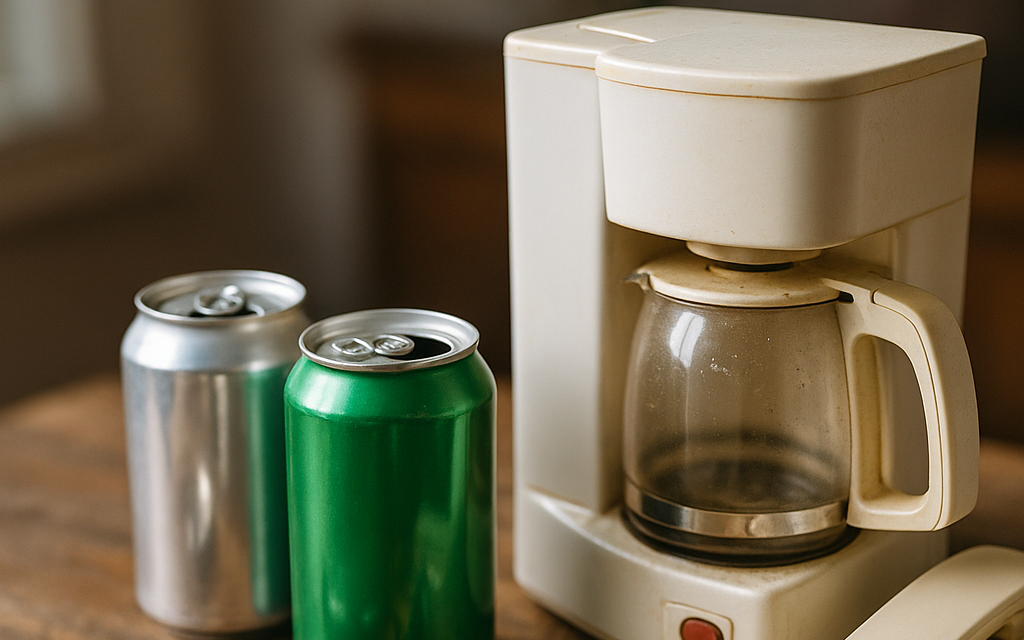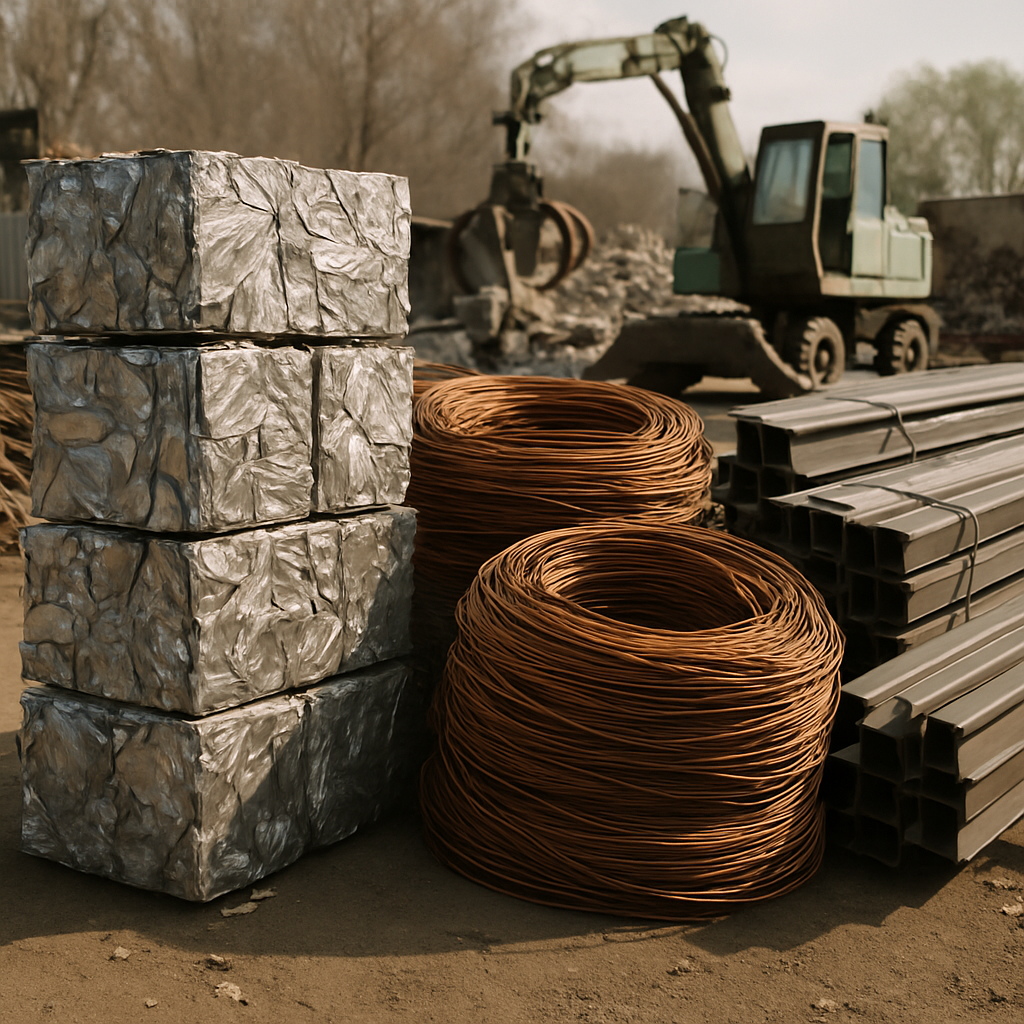5901 Botham Jean Blvd, Dallas, TX 75215
Types of Metals That Can Be Recycled: Complete Guide
September 6, 2025Metals are among the most recyclable materials available. Nearly all metals can be recycled repeatedly without sacrificing their valuable properties, making metal recycling one of the most efficient forms of resource conservation.
Recyclable metals fall into two main categories: ferrous and non-ferrous. Ferrous metals contain iron, which makes them magnetic. These include steel and iron, the backbone of many industries. Steel is the most recycled material worldwide, with over 600 million metric tons consumed annually.
Non-ferrous metals, such as aluminum, copper, brass, lead, zinc, nickel, titanium, and precious metals like gold and silver, do not contain iron. Though they are found in smaller quantities than ferrous metals, they often have a higher value per pound when recycled. Aluminum recycling alone saves up to 95% of the energy required to produce new aluminum from raw materials.
What Are the Benefits of Recycling Metals?

Metal recycling is a highly impactful environmental practice. This process diverts substantial amounts of waste from landfills, where metals would otherwise remain indefinitely. Unlike organic materials, metals do not decompose naturally. Recycling programs help municipalities manage waste more efficiently while extending the operational lifespan of existing landfills.
The conservation of natural resources is one of recycling’s most significant advantages. By processing and reusing existing metals, we greatly reduce the need for mining virgin ore. This preservation is crucial as metal mining causes habitat destruction, soil erosion, and water contamination worldwide.
Energy conservation is another key benefit. According to the U.S. Environmental Protection Agency, recycling steel and tin cans saves between 60-74% of the energy required to produce them from raw materials. Aluminum recycling delivers even more impressive results, using 95% less energy than extracting and processing bauxite ore.
The climate impact is significant. Metal recycling greatly reduces greenhouse gas emissions that contribute to climate change. The Institute of Scrap Recycling Industries reports that metal recycling can reduce greenhouse gas emissions by up to 500 million tons annually. This reduction results from both decreased mining activities and the lower energy requirements of processing recycled materials.
Water conservation also improves through recycling. The process uses up to 40% less water than traditional mining and metal production. This reduction helps preserve this essential resource, especially in regions facing water scarcity or drought conditions.
Economic Benefits of Metal Recycling
The economic advantages of metal recycling are widespread. The recycling industry creates jobs across multiple sectors. According to industry reports, recycling facilities employ hundreds of thousands of workers in the United States alone, generating approximately $117 billion annually in economic benefits.
For manufacturers, recycled metals offer cost-effective raw materials. Companies can reduce production expenses by incorporating recycled content, potentially passing savings to consumers through competitive pricing. This creates a positive economic cycle benefiting various stakeholders.
Scrap metal also offers direct monetary value. Businesses and individuals can sell unused metal items to recycling facilities rather than paying disposal fees. Materials like copper, aluminum, and brass are valuable in the recycling market, creating financial incentives for proper disposal.
The stability recycled materials bring to supply chains is another economic benefit. By reducing dependence on imported virgin materials, domestic industries are shielded from market volatility and supply disruptions. This resource security strengthens manufacturing resilience during economic uncertainties.
Beyond individual businesses, local governments benefit through increased tax revenue and reduced waste management costs. The recycling sector contributes approximately $5 billion annually to local governments, helping fund essential community services.
For both environmental and economic reasons, metal recycling is one of our most valuable sustainability practices. The process creates a virtuous cycle where environmental protection aligns with economic opportunity, demonstrating how thoughtful resource management benefits everyone involved.
How Does the Metal Recycling Process Work?
The metal recycling process transforms discarded metal items into valuable materials used to create new products. This process involves several key steps that efficiently convert scrap metal into reusable resources.
- Collection: The process starts with gathering scrap metal from homes, businesses, and industrial sites. Designated bins help consumers separate different types of metal. For businesses handling large volumes, specialized collection services can arrange transportation to recycling facilities.
- Sorting: Once collected, metals are thoroughly sorted by type and quality. Ferrous metals (containing iron) are separated from non-ferrous metals using magnets. Further sorting by weight, color, and density ensures proper processing to maintain the quality of the recycled material.
- Processing: Sorted metals are compacted and cut into smaller pieces using hydraulic machinery. These pieces are then shredded in hammer mills to create smaller fragments with greater surface area, which melt more efficiently in the next stage.
- Melting: The shredded metal enters large furnaces, calibrated to specific temperatures based on the metal type. Different metals require varying heat levels due to their unique properties. The melting process can take minutes to hours depending on the metal volume and furnace capacity.
- Purification: To ensure quality, the melted metal undergoes purification to remove contaminants. Some metals are purified through electrolysis, where an electric current separates pure metal from impurities. Others are passed under strong magnets to remove unwanted elements.
- Solidification: After purification, the metal is cooled and solidified into forms suitable for manufacturing. Some metals are formed into sheets, while others are compacted into blocks through a process called baling. These standardized forms make transportation and further processing more efficient.
The recycled metal is then transported to manufacturing facilities, where it serves as raw material for new products. This circular process significantly reduces the demand for mining virgin materials, conserving energy and reducing environmental impact.
Each type of metal follows slightly different recycling paths. For example, aluminum recycling requires only 5% of the energy needed to produce new aluminum from bauxite ore, while steel recycling saves enough energy annually to power millions of homes.
The entire metal recycling process creates a closed-loop system where materials move from consumer to recycler to manufacturer and back to consumer, exemplifying the practical application of circular economy principles.
What Common Items Contain Recyclable Metals?

Recyclable metals are all around us in everyday life. From kitchen items to appliances, many household objects contain metals that can be recycled rather than sent to landfills. Knowing which common items contain recyclable metals can help you make more environmentally conscious disposal choices.
Household Appliances
Large household appliances are significant sources of recyclable metals. Refrigerators, freezers, and air conditioners contain substantial amounts of steel in their frames and copper in their cooling systems. These units can be financially rewarding when properly processed for recycling.
Washers and dryers are particularly valuable when dismantled due to their mix of ferrous and non-ferrous metals. Their motors often contain copper windings while their exteriors are typically made of recyclable sheet metal. Dishwashers, stoves, ovens, and water heaters also contain recyclable metal components.
Even smaller appliances like toasters and blenders have recyclable metal parts that can be reused rather than discarded. The metal components in these items are primarily steel and aluminum, both highly recyclable materials.
Kitchen and Household Items
Your kitchen likely contains numerous items made from recyclable metals. Aluminum cookware, pots, and pans are typically made of aluminum, stainless steel, or cast iron—all recyclable metals. For maximum recycling value, remove any plastic or rubber handles before recycling.
Brass faucets, stainless steel sinks, and copper pipes from plumbing systems are also valuable items, particularly during renovations. Aluminum lawn furniture frames and cast iron garden tools contain metals that recycling centers accept.
Even everyday items like metal cutlery, aluminum foil, and food cans are made of recyclable metals. These items are processed differently than larger scrap metals but are equally important to keep out of landfills.
Automotive Parts
Vehicles are among the largest sources of recycled metals annually. Car bodies are primarily made of steel, making them valuable for recycling by weight. Beyond the frame, numerous car components contain recyclable metals.
Specific automotive parts rich in recyclable metals include drums, axles, rotors, and motor blocks. While these ferrous parts may not fetch as much per pound as non-ferrous components, they represent significant recycling opportunities due to their weight and volume.
A single end-of-life vehicle contains metal equivalent to numerous household items. With proper recycling, approximately 80% of a car can be recovered and repurposed, significantly reducing the environmental impact of automotive waste.
Construction Materials
The construction industry generates substantial metal waste that can be recycled. Steel beams, rebar, corrugated iron, and metal framing are commonly found in construction and demolition projects.
Other recyclable construction metals include stairs, railings, wire, metal containers, reinforcements, and fittings. Recycling these materials not only reduces waste but can also offset disposal costs for construction companies and contractors.
When renovating or building, separating metal construction waste for recycling keeps valuable materials in circulation. The steel industry now incorporates up to 93% recycled content in new building materials, making metal recycling crucial to sustainable construction.
Electronics
Electronic devices contain various recyclable metals, though they require specialized recycling processes. Computers and laptops house valuable copper wiring and other metal components that can be recovered when processed properly.
Electronics recycling centers can extract precious metals from circuit boards and other components. This specialized process ensures proper handling of potentially hazardous materials while recovering valuable resources.
Due to the complexity of electronics recycling, these items should be taken to dedicated e-waste collection points rather than general scrap yards. Many recycling facilities have specific guidelines for accepting and processing electronic waste.
Conclusion: The Importance of Metal Recycling

Metal recycling plays a crucial role in environmental sustainability and resource conservation. The process significantly reduces energy consumption; for instance, recycled aluminum requires up to 95% less energy than producing it from raw materials. This substantial energy saving leads to reduced greenhouse gas emissions and a smaller carbon footprint. Beyond environmental benefits, metal recycling preserves valuable natural resources by decreasing the need for environmentally destructive mining operations while diverting millions of tons of waste from landfills annually.
For businesses and individuals aiming to positively impact sustainability goals, metal recycling offers a practical and effective solution. The circular economy generated through metal recycling supports job creation and economic growth while providing cost-effective raw materials for manufacturing. For your metal recycling needs, contact Okon Recycling at 214-717-4083.
